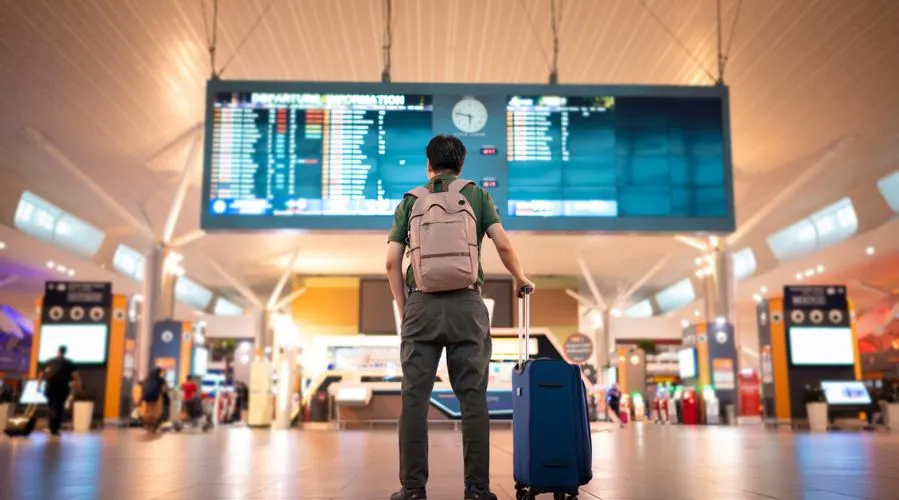Name : Kurt Hambaddael
Date : 07/04/2025
If you’re going to Europe, then there’s a pretty good chance you need a Schengen visa. And applying for one requires patience, time, and, of course, a fair amount of official paperwork.
Some of that red tape may even include what’s known as a No Objection Letter (aka an NOC). In fact, if you’re either an employee or a student, this one particular document may even make all the difference in whether your destination country grants you that visa or not!
But fear not, would-be traveler! To help you understand exactly what a No Objection Letter is, why it's needed, and — most importantly — how to get one, AXA has compiled the comprehensive guide below.
- What is a No Objection Letter (aka NOC) for a Schengen Visa?
- Why do embassies and consulates request a NOC for Schengen visas?
- Is a No Objection Letter mandatory for a Schengen Visa application?
- Who needs a No Objection Letter for a Schengen visa?
- How does the No Objection Letter differ for employed applicants and students?
- Who should write the No Objection Letter (NOC)?
- What information should be included in a NOC?
- What is the proper format for a No Objection Letter?
- How long does it take to get a No Objection Letter?
- How should you submit the No Objection Letter with your Schengen Visa application?
- Common mistakes to avoid when writing a No Objection Letter (NOC)
What is a No Objection Letter for a Schengen Visa?
A No Objection Letter — also commonly referred to as a No Objection Certificate (or simply an NOC) — is a formal legal document. And it can be used in a number of different settings — i.e., banking, real estate, legal proceedings, job or school transfers, and so on.
In the case of the Schengen visa, it’s an official statement — from either your employer, school, or any other relevant authority — confirming that they have no objections (as its name suggests) to your traveling abroad.
A No Objection Letter (NOC) usually includes information such as your position, purpose of travel, and confirmation that you will return after the trip (more on that in a sec!). And it is often requested as part of the documentation for your Schengen visa application.
PRO-TIP: A No Objection Letter may sometimes also be called a “letter of no objection (LONO),” an "employment confirmation letter," or a "letter of leave approval” — but regardless of the name, its purpose remains the same.
Why do embassies and consulates request a No Objection Letter for Schengen visas?
Embassies, consulates, and/or visa application centers mainly require a NOC to ensure that applicants are not overstaying their visas. So by receiving one, they can better verify that the applicant has a stable position or responsibility they need to return to — be it academic or job-related.
For instance, a Schengen embassy might request to see a No Objection Letter to confirm that an employee has secured leave for the duration of the trip — and will return to their job afterward.
Meanwhile, if you’re a student, the letter proves you’re not “ditching school” (i.e., abandoning your education) to live abroad — and that you indeed have permission from said school to travel.
Is a NOC mandatory for a Schengen Visa application?
No. However, while a No Objection Letter is not always required, many Schengen countries will expect you to provide one. So, generally speaking, if you’re employed or studying, it’s always a good call to have one.
Ultimately, a proper No Objection Letter strengthens your visa application by confirming not only that your trip won’t interfere with your professional or educational commitments — but that you’re also doing everything by the book.
Who needs a No Objection Letter (NOC) for a Schengen visa?
So, again, you may need one if you're either employed or a student (or both). And this is especially true for applicants from low and middle-income countries — such as India, Pakistan, Nepal, and Bangladesh.
Having a No Objection Letter (NOC) helps show the European authorities that you’re essentially a temporary traveler. And that you have a solid reason to return home after your trip.
For example, employed applicants may need a letter so that their employer confirms they’ve been granted leave for the duration of the trip — and that their position will be held upon their return.
Students, meanwhile, may need one to demonstrate that their educational institution confirms they are currently enrolled — and that their absence from the school is approved.
How does the No Objection Letter differ for employed applicants and students?
While the idea behind each No Objection Letter is essentially the same, there are a few slight differences — both in who’s doing the writing and what they’re writing about. So here’s a quick breakdown.
No Objection Letter (NOC) for Employed Applicants
For employed applicants, the No Objection Letter (NOC) has to be issued by their employer.
And, generally speaking, it should confirm the applicant’s job title, salary, and approved leave for the travel period.
The letter should also state that the employer has no objections to the trip and expects the applicant to return to their position afterward.
No Objection Letter (NOC) for Students
Meanwhile, for students, the No Objection Letter (NOC) must come from their school or university.
It should confirm the applicant’s enrollment status, the duration of their studies, and that the institution has approved their leave for travel.
PRO-TIP FOR STUDENTS: Be aware that some Schengen embassies may also require proof of enrollment (alongside the NOC, that is).
Who should write the No Objection Letter (NOC)?
Well, it should be someone with the authority to do so — i.e., the people in charge. And who exactly that is will, of course, depend on your particular situation.
But generally speaking, a No Objection Letter (NOC) must be written by a superior — or any person at either your place of employment or academic institution authorized to do so.
For example, it could be a manager, an HR representative, or an academic officer — and not necessarily the Dean or the CEO. So ask around.
PRO-TIP: Whoever your go-to person in charge is — make sure your No Objection Letter is signed and stamped by them.
What information should be included in a No Objection Letter (NOC)?
Generally speaking, a strong No Objection Letter should have these elements:
-Your full name and position (or student status).
-Dates of leave and approval to travel.
-The purpose of the trip.
-A statement of no objection from your employer or school.
-A confirmation that you are expected to return to your responsibilities after the trip.
-The signature and official stamp of the employer or institution.
The individual specifics, however, will again depend on your particular situation (as well as the respective institution and person issuing the letter).
What is the proper format for a No Objection Letter (NOC)?
And the same goes for the format — as there is no one universal template for the No Objection Letter itself. Instead, it is your school’s and/or employer’s responsibility to provide said letter.
But no matter the school or employer, your NOC should be professionally formatted and include, at the very least, the following three sections:
-Header: Your employer or school’s official letterhead.
-Body: The applicant’s details, leave approval, and statement of no objection.
-Footer: Signature and stamp from the appropriate authority.
IMPORTANT NOTE: Your No Objection Letter (NOC) should also be typed, not handwritten — and printed on official letterhead for credibility.
PRO-TIP: Here’s an example of a standard No Objection Letter/NOC — courtesy of the worldwide Schengen visa application outsourcing company VFSGlobal.
How long does it take to get a No Objection Letter (NOC)?
The time it takes to get your No Objection Letter will obviously depend on your particular employer’s and/or school’s internal processes. And since no two schools or employers are ever the same — the wait times can actually vary greatly.
By internet estimates, for example, the process can take anywhere from a day or two to a few months!
Typically though, you should allow seven days for your employer or school to issue the letter after you’ve made the request. And that’s at the very least.
IMPORTANT: And, either way, it's definitely always best to request the letter well in advance of your visa application deadline.
In other words, make sure to give your boss — or HR representative, teacher, academic officer, or whomever else you deem necessary — as much heads-up regarding your travel plans as you can.
How should you submit the NOC with your Schengen Visa application?
The No Objection Letter will be submitted along with your other required Schengen visa application documents — such as your passport, your Schengen visa photos, your Schengen Travel Insurance certificate, and so on. And this will most likely be during the in-person interview phase of your application.
Depending on the Schengen country’s embassy, consulate, or relevant visa application center, you might need to submit it in either paper or digital form. Or both. So be sure to check the embassy’s specific requirements before submitting.
BONUS PRO-TIP: The European Union can help you find your destination country’s embassy, consulate, or visa application center in no time — as its official website provides links to all Schengen diplomatic missions around the world.
Common mistakes to avoid when writing a No Objection Letter (NOC)
And, finally, here are some common mistakes that people overlook when applying. So to ensure there are zero objections from the Schengen authorities to your top-notch No Objection Letter — double- and triple-check that it has no:
Missing Details
Ensure the letter includes all required information — such as your name, dates of leave, and confirmation of your return. Leaving out key details could lead to delays or rejection.
Unclear Language
The wording should be clear— i.e., there must be no ambiguity regarding the no-objection statement. Vague or confusing language can raise doubts, cause unnecessary complications, and cost you valuable time (not to mention the visa itself).
Not Following Embassy Requirements
Always check specific embassy guidelines — as some might require the No Objection Letter in a specific format, with additional supporting documents, and so on.
Failure to comply can result in your visa application being refused too.
PRO-REMINDER: See the EU’s link above to find the embassy/consulate you need!
Handwritten Letters
Although some might, most embassies won’t accept handwritten No Objection Letters — so make sure it’s typed and printed on official letterhead.
A professional, well-formatted letter increases your chances of approval.
And make copies (both digital and physical) just in case too!
FINAL PRO-TIP: While AXA can’t help with your boss or school, we can help with one more big thing.
After all, if you need a No Objection Letter (NOC), then you need a Schengen visa, right? And if you need a Schengen visa — then you’re also going to need some top-notch mandatory Schengen travel insurance.
So while you’re waiting to talk to or hear back from your boss and/or administrative director, why not
compare AXA’s different benefits and get a free AXA quote too?
We guarantee that with the right AXA plan by your side, not only will your trip to the Schengen area be a safe and worry-free one. But as you apply for that Schengen visa, you’re also definitely not going to hear any objections regarding having the proper travel insurance. Which, in turn, can only help make that No Objection Letter of yours look that much more legit, no?
RELATED ARTICLES:
- Schengen visa refusal: how to avoid it?
- Means of Subsistence for a Schengen Visa
- How to apply for a Schengen visa: A Step-by-Step Guide
FAQ
Are there any alternatives to a No Objection Letter?
That depends. In some cases, embassies may accept a leave approval email or some other document from your institution that confirms your travel dates and plans. However, a No Objection Letter is the most formal and reliable option.
How Can a No Objection Letter Improve Your Chances of Obtaining a Schengen Visa?
A No Objection Letter strengthens your application by showing you have strong ties to your home country — thus making it clear that you're not just traveling on a whim (or planning to overstay) but, instead, have a reason to return. It can therefore be a deciding factor for your visa approval.
Can I Submit a Digital Copy of My No Objection Letter, or Does It Need to Be in Paper Form?
It depends on the embassy, consulate, and/or visa application center. Some accept digital copies, while others require physical originals. So always double-check and follow the specific embassy’s guidelines — and reach out to them if in doubt.
AXA already looks after millions of people around the world
With our travel insurance we can take great care of you too
AXA Schengen's Travel Insurances

AXA Schengen Low Cost
AXA Schengen Low Cost is perfect to obtain your Schengen visa. This travel insurance meets all the requirements demanded, covers you in all the countries of the Schengen Area as well as 4 European microstates (Andorra, Vatican City, Monaco and San Marino).

AXA Schengen Europe Travel
AXA Europe Travel is perfect to obtain your Schengen visa. It provides coverage in all Schengen countries + the European microstates + all the EU countries (including UK, Cyprus, Bulgaria, the Republic of Ireland and Romania). And you get additional guarantees compared to AXA Schengen Low Cost.

AXA Schengen Multi Trip
AXA Multi Trip is perfect to obtain your Schengen visa. This annual travel insurance is ideal for those who often travel to Europe as well as multiple-entry Schengen visa holders. You get the same guarantees as AXA Schengen Multi Trip for different countries during 90 days.


